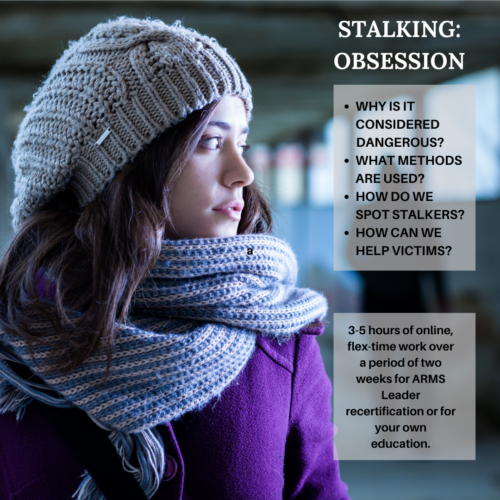NOTE: To pay with a credit or debit card, please scroll to bottom and choose "ADD TO CART".
ABOUT THE CLASS: Stalking is one of the most dangerous signs of obsession that a person can exhibit. Stalking victims have a much higher chance of being seriously injured or killed by their stalker than abuse victims who are not stalked. Learn how to spot a stalker, why they stalk, common stalking behaviors, the mentality of a stalker and how to help stalking victims. Online, flex hours, 3-5 hours of time over a two week period. For your professional knowledge or ARMS Leader Recertification."Thanks for the incredible training I learned a lot and am sure I will be referring to my notes often in the future." -K.S.
"I was very pleased with the course material. There is a lot that I learned about stalking that I had not considered as being a form of stalking. I considered most or all of the six stages as abuse or boundary issues, but didn’t consider them as stalking...It was an eye opener about the media and subtle messages about stalking. They will better prepare me for what to look for and recognize... All-in-all it was a great learning experience and I feel it will benefit me a lot as a leader in the industry." -L.D.
"Helpful class to give a vocabulary to stalking behaviors and to know what victims of stalking can do to protect themselves...Would have been helpful six months ago when I was walking with a client through this. Thanks for the class-it was awesome!" -S.H.
"Although I have really appreciated every recertification class I have taken, this has been the most appreciated because I was ignorant of so many of the resources that were highlighted throughout the training. When I read the different articles about grey rocking, I was reminded that God led me to respond to my ex-husband with grey rocking although at the time I didn’t know grey rocking existed. It took 5 years for me to perfect grey rocking and it was worth every stumbly bumbly effort." -K.S
"This particular class was very infomative for me. I learned alot. I especially liked all the practical downloads and sites that provided information that i can now use to help others." -M.T.
"What a great course! Everything is helpful; the section on what victims can do with the links, Stalking Incident and Behavior Log, and all the great links are very empowering. I will keep hard copies of everything available with me, in my class, to refer to for any students who may need this information in the future. Thank you for putting this together." - S.C






